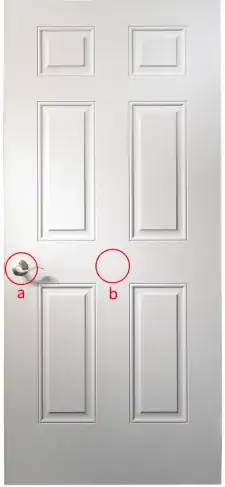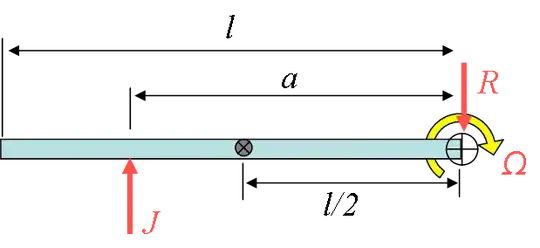Assuming an ordinary hinged door ($M = 3Kg$, L = 1m), would it take
more energy to open it when applying force in the middle of the door
(point b: $r=50cm$), rather than at the end of the door (point a $r=100cm$), My own answer is no, since the change in force would be
proportional to the distance required to open the door and therefore
the total energy would remain the same.
The issue is not so simple: the equation $E = F*d= F_1*r_1 = F_2*r_2$ is valid only with a lever, where forces are balanced across the fulcrum F. (left sketch)

In a door, the center of mass is not at the fulcrum, but at half-length, and the effective mass $m°$of the door varies between $M/3$ (at tip) to $\infty$ (at fulcrum), according to the formula of the rotational mass divided by the square of the distance from the fulcrum/hinge (right diagram): $$m° = \frac{[M]=3*l^2=[1]}{3*d^2}= \frac{1}{d^2}$$
Therefore the nearest to the hinge you are applying the force/impulse, the more energy is required to obtain the same result (the same change of momentum), because the effective rotational mass increases as you get near the fulcrum. In a lever, the mass of the arm is not considered as it is constant, on a hinge, the energy required to displace the door at point $b$ is roughly proportional to the increased mass $E = m*a*d$. I said roughly, because applying a force/torque to a pivoted object is more complex than it may seem, because you have to distinguish between fixed load and follower load. But, grossly simplifying, we may say that it takes a lot more energy at point $b$. Friction and wasted energy are just red herrings
If at first you find this hard to believe, just think that if you apply any force bang to the hinge, no matter how great, the door won't budge. (Unless you bring down the wall, of course). Now, this change of result can't be abrupt, must increase gradually, an it does, by the inverse square law.
What about the situation where you forcefully push the door open ( $J=10kgm/s$),
rather than pushing it with the same acceleration throughtout the
whole movement? – JonathanReez
!
Considering an impulse $J$ (any force must be applied for a time, every force is an impulse) greatly simplifies your calcs. Even though the results are some what different, the principle, is un-changed.
Same for the idea that the change in the door's position can't be
abrupt as you move the point of application of the force from the
hinge further out. The door won't move if you push at the hinge; it
will move if you push elsewhere. That is an abrupt change. . –
David Z♦

Practically you are affirming that: if you give K J of energy (the question was about energy so we must always condider that) at point A, the door will not move, then, if you apply same force at 0.0001 m from the hinge (B) or at 1 m distance (C) .the door will move with same angular velocity/momentum/energy.
If that is what you meant, it needs no comment.
I am ready to admit this post is incorrect, if someone shows a (any) concrete example (with real figures) of same force applied at B and C with same result.





